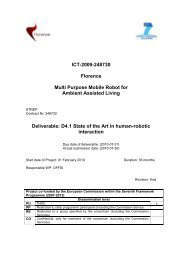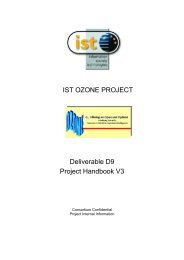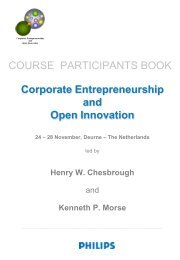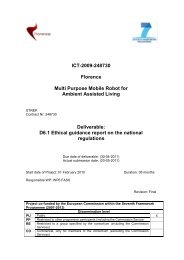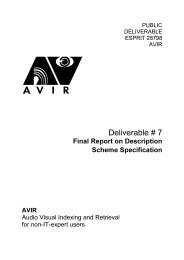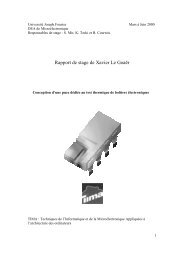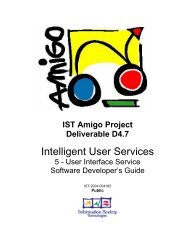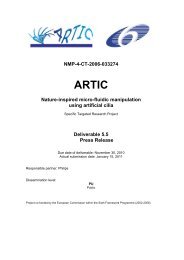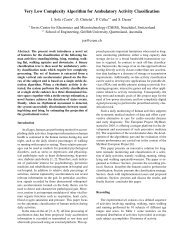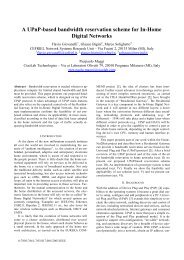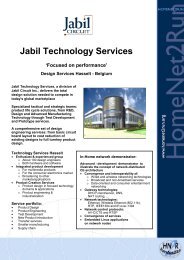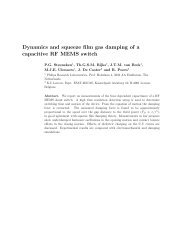PHILIPS RESEARCH – DTS Report nr 06-012 ... - Hitech Projects
PHILIPS RESEARCH – DTS Report nr 06-012 ... - Hitech Projects
PHILIPS RESEARCH – DTS Report nr 06-012 ... - Hitech Projects
Create successful ePaper yourself
Turn your PDF publications into a flip-book with our unique Google optimized e-Paper software.
<strong>PHILIPS</strong> <strong>RESEARCH</strong> <strong>–</strong> <strong>DTS</strong> <strong>Report</strong> <strong>nr</strong> <strong>06</strong>-<strong>012</strong><br />
- Philips restricted <strong>–</strong><br />
Wafer Bonding: The Suss MicroTec substrate Bonder SB6e and the Suss<br />
bond Aligner BA6.<br />
Marice van Deurzen, Hans Reurings, Peter Kuijpers<br />
Philips Research Laboratories, Prof. Holstlaan 4, 5656 AA Eindhoven, The Netherlands<br />
e-mail: marice.van.deurzen@philips.com<br />
Since september 20<strong>06</strong> a Suss MicroTec substrate bonder SB6e and a Suss bond Aligner BA6 are available in<br />
the clea<strong>nr</strong>oom MiPlaza at the Nat.Lab. The aligner is used to align the wafers, wafer to wafer, with Back Side<br />
Alignment (BSA). The substrates can be silicon, glass or pyrex wafers. The bonder is a universal tool for bonding<br />
processes for micro electro-mechanical system applications such as MEMS, micro-fluidics, substrate transfer,<br />
wafer level packaging and bio-chips.<br />
1. Introduction<br />
Within all of these bonding techniques a lot of<br />
materials are used, see overview below.<br />
- Anodic Bonding glass/pyrex Si<br />
- Silicon Fusion Bonding Si-Si<br />
- Adhesive Bonding SU-8, BCB<br />
- Thermal Compression Bonding<br />
Au-Au, Cu-Cu, Cu-Sn-Cu<br />
- Eutectic bonding Au-Si,<br />
- Temporary Bonding<br />
The most critical parameters are: intermediate<br />
layer, pressure, temperature, and time<br />
2. The aligner<br />
The aligner is shown in figure 1.<br />
Some features are:<br />
- Aligning in a controlled environment.<br />
- Wafer and substrate size is 6 inch at the<br />
moment and in the future 8 inch, both circular.<br />
- Thickness of the total stacked wafers is<br />
maximum 6 mm.<br />
If two silicon wafers have to be aligned on the<br />
aligner, markers on the backside of one of the<br />
silicon wafers are required.<br />
Fig. 1: Suss bond Aligner BA6<br />
After alignment on the aligner the substrate<br />
stacks are either mechanically clamped using<br />
the transport fixture (figure 2) for further<br />
processing in the bonder. So the machine is a<br />
semi automatic tool.<br />
© Koninklijke Philips Electronics N.V. 20<strong>06</strong> Format: RWV-010-950-003/01 11 December 20<strong>06</strong>
<strong>PHILIPS</strong> <strong>RESEARCH</strong> <strong>–</strong> <strong>DTS</strong> <strong>Report</strong> <strong>nr</strong> <strong>06</strong>-<strong>012</strong><br />
- Philips restricted <strong>–</strong><br />
Fig. 2: Suss bond Aligner BA6 <strong>–</strong> inner detail<br />
3. The bonder<br />
The bonder is shown in figure 3.<br />
Features are:<br />
- Bonding in controlled environment.<br />
- Wafer and substrate size is 6 inch at the<br />
moment and in the future 8 inch, both circular.<br />
- Vacuum down to 5x10e⎯5 mbar.<br />
- Max tool force is 20,000N<br />
- Overpressure up to 3 bar absolute.<br />
- Temperature top and bottom chuck is 500°C<br />
Fig. 3: Suss MicroTec substrate bonder SB6e<br />
A schematic view of the process chamber is<br />
shown in Fig. 4 and consists of a<br />
- Chamber body<br />
- Chamber door<br />
- Chamber lid<br />
4. Conclusion<br />
The bonder is a universal tool for bonding<br />
processes for micro electro-mechanical system<br />
applications such as:<br />
- Anodic Bonding<br />
- Silicon Fusion Bonding<br />
- Adhesive Bonding<br />
- Thermal Compression Bonding<br />
The first bonding experiments are started but a<br />
lot of research still needs to be done on this<br />
machine to find the optimal settings for each<br />
bonding technique.<br />
Fig. 4: Schematic scheme of the bonder<br />
© Koninklijke Philips Electronics N.V. 20<strong>06</strong> Format: RWV-010-950-003/01 11 December 20<strong>06</strong>



